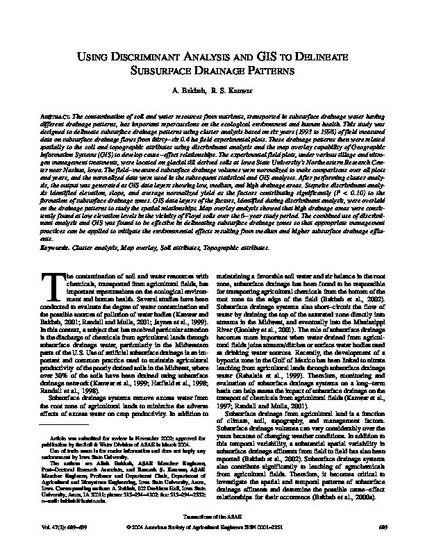
The contamination of soil and water resources from nutrients, transported in subsurface drainage water having different drainage patterns, has important repercussions on the ecological environment and human health. This study was designed to delineate subsurface drainage patterns using cluster analysis based on six years (1993 to 1998) of field measured data on subsurface drainage flows from thirty-six 0.4 ha field experimental plots. These drainage patterns then were related spatially to the soil and topographic attributes using discriminant analysis and the map overlay capability of Geographic Information Systems (GIS) to develop cause-effect relationships. The experimental field plots, under various tillage and nitrogen management treatments, were located on glacial till derived soils at Iowa State University’s Northeastern Research Center near Nashua, Iowa. The field-measured subsurface drainage volumes were normalized to make comparisons over all plots and years, and the normalized data were used in the subsequent statistical and GIS analyses. After performing cluster analysis, the output was generated as GIS data layers showing low, medium, and high drainage areas. Stepwise discriminant analysis identified elevation, slope, and average normalized yield as the factors contributing significantly (P < 0.10) to the formation of subsurface drainage zones. GIS data layers of the factors, identified during discriminant analysis, were overlaid on the drainage patterns to study the spatial relationships. Map overlay analysis showed that high drainage areas were consistently found at low elevation levels in the vicinity of Floyd soils over the 6-year study period. The combined use of discriminant analysis and GIS was found to be effective in delineating subsurface drainage zones so that appropriate management practices can be applied to mitigate the environmental effects resulting from medium and higher subsurface drainage effluents.
Available at: http://works.bepress.com/rskanwar/113/

This article was published in Transactions of the ASAE. Vol. 47(3): 689-699, doi:10.13031/2013.16101. Posted with permission.